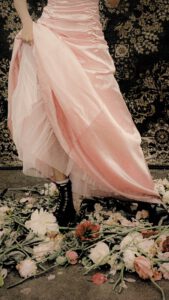Affiliate Disclosure
Some of the links on this page may be affiliate links. As an Amazon Associate, I earn from qualifying sales from these links. If you make a purchase or sign up for a membership through these links, I will receive a small commission. This will not cause any additional costs for you. This income helps us to run this website and especially the blog for you.
A new format: design stories
I’ve been thinking about a new format for our blog. In certain sections I will introduce different designers, in our “design stories”. We talk about life, the particular style, perhaps the difficulties of each designer and much more. Today’s post starts with the queen of punk: Vivienne Westwood.
Vivienne Westwood
Dame Vivienne Isabel Westwood was a British fashion designer known for her unconventional and provocative designs. In this post, we take a look at her career, her life, and her unique designs.
Origin and life before her career as a designer
Vivienne Westwood was born in England in 1941. Her mother Dora worked as a weaver in a local cotton mill. Her father came from a family of shoemakers. Presumably, these aspects already shaped Vivienne and sparked her interest in fashion crafts, even though her parents changed professions after World War II and took over a small post office. Vivienne was attending Harrow Art School at the time and studied there for one semester each, fashion, fine art and silversmithing.
Apparently, however, a career in this field was not yet conceivable for her at that time, as the daughter of a working-class family. She then became a teacher and taught at an elementary school starting in 1961. From a short marriage with Derek Westwood comes her son Benjamin Arthur Westwood, who was born in 1963. After her divorce in 1965, she met Malcolm Edwards (a.k.a. Malcolm MacLaren), then only 18 years old. The two had a son together, Joseph Corre, two years later.
By this time, she had regularly designed and sewn clothes for herself and began sewing clothes for her sons as well. Which was not only a hobby, but also a necessity for her, since she was not financially well off at that time. To do this, she not infrequently copied existing garments by cutting them up and creating patterns from them.
Early career
Vivienne Westwood’s career as a designer began from 1971. Together with her then partner Malcolm McLaren, she opened the store “Let It Rock”, inspired by a Chuck Berry song, in King’s Road in London, where she sold second-hand clothes and teddy-boy style clothing, which at that time also corresponded to her personal style, or McLaren. With this style, McLaren in particular saw himself as part of a counter-movement to the more dominant hip style of the time, which he downright despised. However, as the so-called “Teds” became increasingly associated with racism and sexism, she distanced herself from this youth movement. At that time Vivienne Westwood designed her fashion and had it produced in still very small style with the help of a tailor and a seamstress.
They eventually changed the name of their store to “Too Fast To Live, Tor Young To Die” in 1973, in recognition of iconic actor James Dean. During this time they changed their style towards rocker fashion. Just a year and a half later, they again changed the name of their store to “Sex” and began designing punk-style clothing. At that time, they also supplemented their assortment with erotic lingerie and S&M items. The designs were provocative and rebellious and contributed to the development of punk culture. Her boutique became a well-known meeting place in the London punk rock scene. Among their customers at the time were also well-known members of various bands, for example, the later Sex Pistoles.
She changed the name of the store three more times, until it finally remained under the name “World’s End” since 1979.
Punk designs
Vivienne Westwood’s punk-style designs had become an important part of the British fashion scene in the 1970s. She designed clothes that rebelled against the traditional fashion world and social norms of the time. Among her most famous designs were the “Seditionaries” t-shirt print and the “Anarchy in the UK” sweater. These designs were provocative and rebellious and contributed to the development of punk culture.
New Romanticism
In the 1980s Vivienne Westwood turned away from punk culture and began to design clothes in the style of the “New Romantic” movement. These designs were opulent and romantic and included elements such as corsets, ruffles and lace. Her designs for wedding gowns were particularly successful, combining the “New Romantic” style with her own rebellious aesthetic.
In 1981, she designed her first professional fashion collection called “Pirates”, which she also presented as a catwalk fashion show at the London Designs Collection in the Olympic Exhibition Hall. At the same time she redecorated her store in pirate style. Since then, the famous clock, running fast backwards, with 13 digits also adorns the facade of the store.
Paris
In 1982 Vivienne Westwood had her collections shown for the first time in Paris. The world capital of fashion. This made her the first English fashion designer to do so since Mary Quant in the 1960s. With her collection “Nostalgia of the Mud” she approached the country and cowboy style at that time. With mud-colored, tattered textiles, she wanted to represent era of post-industrial society and simpler nature. Significant elements of this collection were also large buffalo hats, as well as lambskins and embroidery. For this collection she even opened another store in London at St. Christopher’s Place, under the same name “Nostalgia of the Mud”.
Setbacks
Since 1983, after the divorce from McLaren, she continued to work on her collections independently. However, their brand ran into financial trouble after the breakup. “World’s End” had to close and could not be reopened until three years later. At that time, she had signed a licensing agreement with Giorgio Armani for financial reasons. This allowed Armani to produce and distribute their fashion and was originally to run for seven years. However, the contract was terminated after only four years.
The recovery
After only one new collection in 1985, called “Mini Crini”, in which Vivienne Westwood deliberately distanced herself from the then trendy large shoulder pads and designed, among other things, narrow landed gentry jackets, she took a creative break for a year, which she spent in Italy. In that year, she also designed her logo, which is still known today.
Harris tweed
A rather struggling British tweed company at the time even supported her brand financially in the following years after releasing a collection of their tweed fabrics in 1987, which helped Harris Tweed and tweed in general really take off. The Harris Tweed collection was characterized by artisanal and elegant cuts and marked another important turning point in her career as a fashion designer.
Your teaching work
In addition to many other extraordinary collections that were to follow in the 90s and 200s, Vivienne Westwood also accepted teaching positions from 1989 to 2005. She taught fashion design at the University of Applied Arts in Vienna and was a professor at the University of the Arts in Berlin, where she was even made an honorary senator.
The later years
Vivienne Westwood was considered a hard worker who often sat at the sewing machine herself and was actively involved in the creation of her collections. She was also said to be a harsh critic. She was also very committed to human rights, peace, and environmental and animal protection. From 2007 on, she renounced the use of real animal cases in her collections and called for resistance against propaganda of any kind and for consumer renunciation in the context of the “Berlin Lessons” at the then Berlin Festival.
Her “Queen of Punk” image is said to have not even appealed to her personally, at least not in the later years. She pleaded for classical education, for example, and literally said “every time I read a book, instead of a magazine, go to an art department, instead of watching television, or go to a theater, instead of a movie theater, I fight for an active resistance to propaganda” Her manifesto “Active Resistance to Propaganda” published at that time was rather laughed at by the press and Westwood was judged “naive” and “conservative-elitist” for it.
Your legacy
Vivienne Westwood has received various awards and much recognition between 1990 and 2019. She was an extremely dedicated personality. Despite criticism, she has apparently always remained true to herself. She was a rebel, not only in the fashion industry. Their fashion brand is known all over the world. Her youngest son, Joseph Corre, has followed in her footsteps and is now also a fashion designer. Since 1992 she had been married again to the Tyrolean Andreas Kronthaler, who had once been her student at the Vienna University of Applied Arts. He was only able to convince her to move to a historic 1703 Queen Anne-style estate in 2000. Until then, she had lived modestly in a small council apartment in Clapham for 30 years.
On December 29, 2022 Vivienne Westwood, died at the age of 81 in London in the circle of her relatives.
Conclusion
Vivienne Westwood was an extraordinary designer known for her unique designs and rebellious personality. Her designs have had a lasting impact on the fashion world and her career is proof that it pays to be bold, creative and have staying power. She broke the boundaries of the traditional fashion world and showed that fashion can also be a form of political protest. Her designs will continue to inspire and influence the fashion world. Anyway, researching her extraordinary life for this article was a great source of inspiration for me. I hope you enjoyed my first “design story”. What do you think of Vivienne Westwood? What do you think of her fashion and style? Did you find her story inspiring? Feel free to let me know in the comments.
I wish you an extraordinary weekend.
All the love
Christina
“The only impact you can have on the world happens through unpopular ideas.”
Vivienne Westwood
Share this post:

We’re excited
to share our news with you!
Would you like to receive information about our latest articles and our latest products directly in your mailbox?
Sign up for our newsletter!
We’d love to keep you in the loop.
About the author

Christina Ernst is founder and CEO of Linen & Quince. She is also a designer, author and real estate expert. She shares her experiences and knowledge not only on our Linen & Quince blog, but also on her personal blog, christinaernst.net , where she writes about financial knowledge, starting a business, real estate knowledge and personal development. She loves interior design, art, antiques, as well as elegant, sustainable and high-quality fashion.



